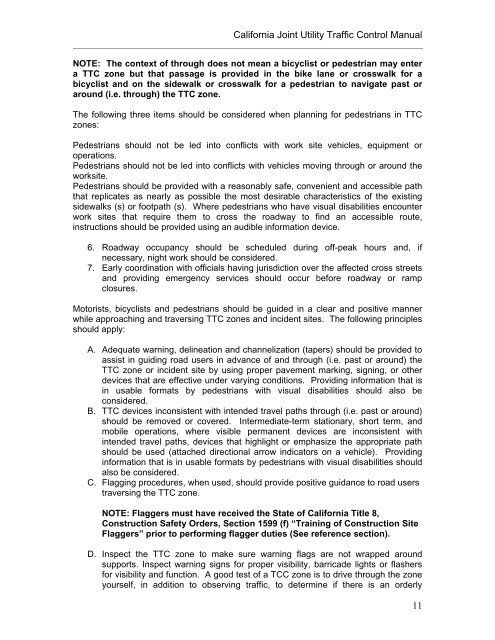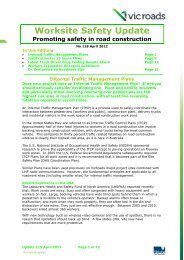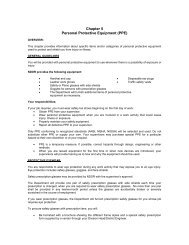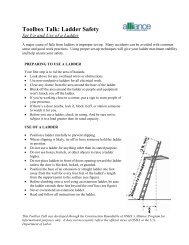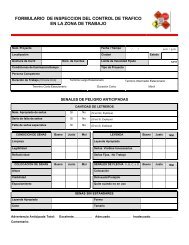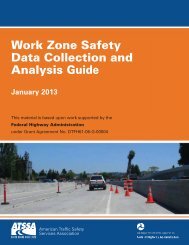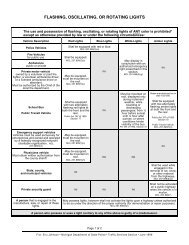California Joint Utility Traffic Control Manual - National Work Zone ...
California Joint Utility Traffic Control Manual - National Work Zone ...
California Joint Utility Traffic Control Manual - National Work Zone ...
Create successful ePaper yourself
Turn your PDF publications into a flip-book with our unique Google optimized e-Paper software.
<strong>California</strong> <strong>Joint</strong> <strong>Utility</strong> <strong>Traffic</strong> <strong>Control</strong> <strong>Manual</strong><br />
NOTE: The context of through does not mean a bicyclist or pedestrian may enter<br />
a TTC zone but that passage is provided in the bike lane or crosswalk for a<br />
bicyclist and on the sidewalk or crosswalk for a pedestrian to navigate past or<br />
around (i.e. through) the TTC zone.<br />
The following three items should be considered when planning for pedestrians in TTC<br />
zones:<br />
Pedestrians should not be led into conflicts with work site vehicles, equipment or<br />
operations.<br />
Pedestrians should not be led into conflicts with vehicles moving through or around the<br />
worksite.<br />
Pedestrians should be provided with a reasonably safe, convenient and accessible path<br />
that replicates as nearly as possible the most desirable characteristics of the existing<br />
sidewalks (s) or footpath (s). Where pedestrians who have visual disabilities encounter<br />
work sites that require them to cross the roadway to find an accessible route,<br />
instructions should be provided using an audible information device.<br />
6. Roadway occupancy should be scheduled during off-peak hours and, if<br />
necessary, night work should be considered.<br />
7. Early coordination with officials having jurisdiction over the affected cross streets<br />
and providing emergency services should occur before roadway or ramp<br />
closures.<br />
Motorists, bicyclists and pedestrians should be guided in a clear and positive manner<br />
while approaching and traversing TTC zones and incident sites. The following principles<br />
should apply:<br />
A. Adequate warning, delineation and channelization (tapers) should be provided to<br />
assist in guiding road users in advance of and through (i.e. past or around) the<br />
TTC zone or incident site by using proper pavement marking, signing, or other<br />
devices that are effective under varying conditions. Providing information that is<br />
in usable formats by pedestrians with visual disabilities should also be<br />
considered.<br />
B. TTC devices inconsistent with intended travel paths through (i.e. past or around)<br />
should be removed or covered. Intermediate-term stationary, short term, and<br />
mobile operations, where visible permanent devices are inconsistent with<br />
intended travel paths, devices that highlight or emphasize the appropriate path<br />
should be used (attached directional arrow indicators on a vehicle). Providing<br />
information that is in usable formats by pedestrians with visual disabilities should<br />
also be considered.<br />
C. Flagging procedures, when used, should provide positive guidance to road users<br />
traversing the TTC zone.<br />
NOTE: Flaggers must have received the State of <strong>California</strong> Title 8,<br />
Construction Safety Orders, Section 1599 (f) “Training of Construction Site<br />
Flaggers” prior to performing flagger duties (See reference section).<br />
D. Inspect the TTC zone to make sure warning flags are not wrapped around<br />
supports. Inspect warning signs for proper visibility, barricade lights or flashers<br />
for visibility and function. A good test of a TCC zone is to drive through the zone<br />
yourself, in addition to observing traffic, to determine if there is an orderly<br />
11


